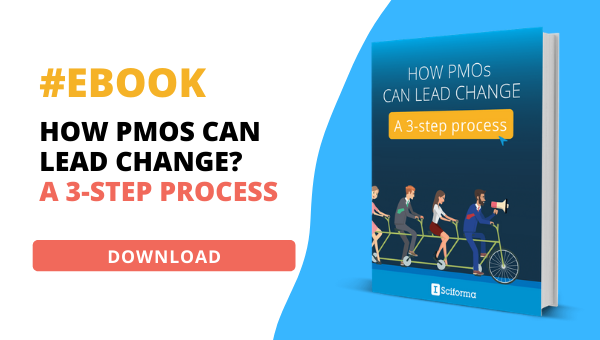Since you are reading this, you’re quite probably wondering if your organization stands to benefit from the creation of a Project Management Office (PMO). Establishing a PMO obviously requires tapping into your company’s funds and resources, so it definitely makes sense to ensure that such an organizational body is suited to your company before committing time, money, and effort.
Although PMOs are increasingly popular, they tend to be more prevalent in specific types of companies. As we will see, the likeliness for a business to have a PMO depends on a variety of factors and criteria, including size, business model complexity, technology and PPM maturity, industry, ways of working, approach to project management, culture, and more.
Many other organizations would vastly benefit from setting up a PMO but have refrained from creating one because they assume wrongly that it is not a fit for them. Let’s explore the most common “natural habitats” for PMOs as well as the companies that should have a PMO but don’t know it yet.
Preliminary definition
To make sure we’re off to a good start, let’s lay out a concise definition of the Project Management Office. Here is how Wikipedia (usually a go-to for objective overviews) defines the PMO: “A project management office (abbreviated to PMO) is a group or department within a business, government agency, or enterprise that defines and maintains standards for project management within the organization. The PMO strives to standardize and introduce economies of repetition in the execution of projects. The PMO is the source of documentation, guidance and metrics on the practice of project management and execution.”
In addition to that role as a standardizing agent, the PMO often monitors and controls the performance of project execution, selects and implements dedicated PPM tools, coordinates the management of programs and portfolios, develops a process to optimize resource allocation and management, fosters cross-team collaboration and institutional learning, and increases the strategic fitness of project activity. In sum, a Project Management Office can drive improvements across a wide array of project-related areas.
PMO Natural Habitat #1: Complex Organizations
It usually doesn’t take much to ensure proper execution and completion of a handful of small, occasional projects. A team of Project Managers using basic processes and general-purpose tools is generally enough. Until a certain point. When project activity reaches a certain scope and level of complexity, organizations bump up against the limits of casual project management.
High-growth businesses
Typically, this happens when the company scales up operations. As the organization grows in scope and size and takes on larger numbers of bigger projects, teams start to feel the need for a central function to coordinate the various initiatives.
Whereas a small club of Project Managers generally maintains focus on day-to-day project operations, a PMO is empowered to see and analyze the interdependencies and interrelations between multiple projects across multiple business units or departments. With a higher-level vision, the Project Management Office can decide which projects should take priority, which should be undertaken first, and which should have privileged access to funding and critical resources. The PMO may also choose to bundle projects together into programs to improve execution efficiency, or to organize the initiatives into one or multiple portfolio(s) to maximize strategy alignment and business value.
Additionally, a Project Management Office makes sure that the enterprise has the tools to match the expanded scope of project activity. While basic project management tools do great when it comes to delivering a few simple projects, scaling up requires the support of PPM or PMO tools that are specifically designed to help oversee and optimize large numbers of interrelated projects.
This is why organizations eventually reach a point along their growth journey where the need for a formal Project Management Office becomes too strong to ignore.
Complex-by-design businesses
Complexity is not only a matter of size. For companies active in volatile, high-risk or capital-intensive industries, project complexity is a fact of life from day 1.
Some organizations engage in blue-sky innovation and run cutting-edge Research and Development projects with no guaranteed outcome — for example, in the fields of Artificial Intelligence or bioengineering.
Others must comply with stringent regulatory requirements — as is the case in pharmaceuticals, aerospace or avionics.
Some innovation-centric enterprises need to document project activity with extreme accuracy in order to claim research subsidies and grants.
Others highly dependent on scarce, specific skilled labor — like data scientists or cybersecurity specialists — and just can’t afford to waste a minute of the time of their critical resources.
More still must deal with high exposure to economic and market factors — a case in point is financial services or commodity trading.
Some undertake huge projects with lengthy cycles and high levels of uncertainty at the outset — for example, large infrastructure projects, which are contingent on material, as well as climatic and even political conditions.
When faced with extreme complexity, or when managing challenging, high-stake initiatives, there is just no room for approximation or test and learn. You have to do it right the first time around. Accordingly, businesses operating in such industries are typically among the first to set up a Project Management Office in a bid to improve project management reliability.
Businesses with pressing problems to solve
Among the key drivers for establishing a Project Management Office is the need to fix specific business issues. As a hub for Project Portfolio Management across the organization, the PMO is aware of and involved in work activities across domains. PMOs also act as central coordinators between diverse teams. A Project Management Office is therefore the ideal vehicle to introduce and disseminate improvements to the ways of working and to circulate best practices throughout the business in order to tackle systemic problems.
For instance, the quality and consistency of project delivery may suffer from collaboration issues — these are particularly common in matrix enterprises with distributed project ownership.
Other organizations are clobbered by subpar project work productivity due to lacking or inconsistent methodologies, or by project manager time wasted on valueless administrative tasks that could and should be automated.
Some businesses find that their projects tend to miss the mark because the decisions are made based on inaccurate or outdated data. Others hemorrhage money because they mis- or under-utilize sought-after — and, therefore, handsomely paid — critical project resources.
High project failure rates, poor quality of deliverables, inability to keep project costs under control… The project-related problems that may weigh on the performance of a business and endanger its very survival are many. A good deal of these issues can be mitigated by the creation of a Project Management Office. As a result, it is not uncommon to find a PMO in organizations that made it after a rocky start or managed to regain footing after a challenging phase.
PMO Natural Habitat #2: High PPM Maturity Organizations
Once foundational PPM processes and systems have been introduced and accepted by users, and once they produce measurable results, organizations often feel the need to move up to the next level. A Project Management Office is usually the key to unlocking the benefits of advanced Project Portfolio Management.
A PMO to enable more sophisticated portfolio management
In order to maximize the value of project management activities, mature populations of PPM professionals seek greater empowerment and effectiveness at scale. Teams of seasoned, high-skill Project and Portfolio Managers want to refine PPM methodologies, processes, and further develop documentation. What better than to appoint a dedicated body to centralize and maintain the system? What better than a PMO to own the organizational change that’s required to optimize Project Portfolio Management?
In response to the need to achieve further performance leaps in mature organizations, a Project Management Office will review the programs and portfolio with a view to overhauling or fine-tuning the methodologies in place. PMOs create action plans with clear quantified targets and put together a team to plan, structure, and orchestrate the changes.
PMOs also strive to enhance visibility into projects and to provide more granular understanding of activities to improve the organization’s ability to evaluate and maximize the business value of multiple interrelated projects against the strategic objectives. How? By leveraging the capabilities of a PMO software tool.
A PMO to deploy a PMO tool
While general-purpose tools for managing projects, resources, and time are usually enough to handle limited numbers of short-duration and low-complexity projects, mature teams need industry-grade capabilities to take on more, larger projects and manage interdependencies at the portfolio level. Adaptive Project Portfolio Management platforms enable advanced financial modelling, fine-grain project planning, and resource allocation, while analytics and simulations provide insights to inform trade-offs and decisions.
A Project Management Office will select the tool that best matches the organization’s needs, oversee implementation, and tackle the change management issues. Introducing a new tool generally brings about significant change in ways of working. The PMO provides information, training, and ongoing support to drive the required behavior adjustments and ensure proper user adoption.
Oftentimes the deployment of a PMO-vetted PPM software tool also serves the purpose of avoiding or solving a software proliferation problem. As PPM awareness and maturity grow in the various areas of the business, different stakeholders may decide to acquire and roll out their own local management system. As a result, the enterprise may end up with a whole collection of different PPM software tools, which threatens consistency and hinders collaboration. The Project Management Office is responsible for making sure that everyone uses the same products and the same standards.
PMO Natural Habitat #3: Digital businesses
Digital businesses — organizations which have embraced a digital operating model whereby IT and digital technologies are core to the pursuit of strategic objectives and outcomes — are increasingly prevalent. Even large enterprises in industries perceived as somewhat traditional — manufacturing for instance — are taking the leap, either hoping to seize new opportunities and gain market advantages, or prompted by the necessity to emulate competitors in order to maintain their position. According to Gartner, by 2023, 80% of organizations will have an enterprise PMO focused on integrating digital products and programs.
Project cycle times
Digitalization is driving shorter and shorter project cycle times. The traditional systems, processes, and tools in place in most enterprises are not designed to support those shorter delivery models. Accordingly, digital businesses increasingly turn to PMOs to adapt their PPM delivery processes to the new speed and agility imperatives. A Project Management Office is created to introduce leaner approaches to project execution and explore Agile methodologies with focus on adaptive, iterative work.
Innovation and cultural change
This will encourage innovation and a test-and-learn mindset that goes hand-in-hand with digitalization. PMO teams make sure that the tools and technologies in use fit the current needs and support digital PPM (including support for Agile or hybrid project management methodologies). They typically favor user-friendly, scalable, and flexible tools under software-as-a-service delivery models to support the company along its development and digitalization path. As they rethink the approach to delivery, PMOs promote and facilitate the cultural and behavioral change required for the organization to operate as a fully digital business.
Digital transformation is also driving a move to product management and product-centric delivery. According to Gartner, 75% of top-performing organizations have already implemented product-centric delivery. This shift to a product focus has a deep impact on PPM processes, practices, roles, and technologies.
Supporting product management
Organizations, which embrace product management, are relying on PMOs to adapt Project Portfolio Management disciplines in order to support product management. This may involve rebalancing teams across activities and portfolios or ensuring product roadmapping alignment. A Project Management Office will also support that new direction by promoting the development of more customer-centric competencies and roles, by creating a mindset of agility, by introducing design thinking concepts and by improving understanding of customers — both internal and external.
The business categories described above have the most obvious and compelling reasons to implement a PMO. It shouldn’t come as a surprise that they are the most likely to have one.
Yet many other organizations could definitely use a Project Management Office… even though they might not be aware of it.
“Too Small” for a PMO?
Among the categories of businesses that often feel that they don’t need a PMO are organizations with lower PPM maturity, especially in low-tech, low-capital-intensity industries (professional services firms are actually less likely to have a PMO), and smaller businesses. Young or small- to mid-size companies often think that they are too small to have a Project Management Office, and that the benefits would not outweigh the investment. Evidence proves them wrong. All project-centric businesses — including startups and SMEs — can benefit from a Project Management Office. Actually, it’s common to see “acting PMOs” — people who try to play that role without the recognition, authority, and means — in small businesses.
Smaller size companies don’t necessarily have to appoint a full-time PMO. This list of PMO activities and responsibilities can be fairly short. For example, tightening and improving relationships between Project Managers and other stakeholders throughout the company, ensuring the quality and freshness of information, sharing good practices and knowledge, and introducing a modicum of standardization into processes and metrics. Even if it’s a lightweight PMO, having a Project Management Office makes all the difference.
Want more information about the Project Management Office?
- The Role of the PMO in Project Portfolio Management
- The Culture of a Project Management Office
- What are the functions of a Project Management Office?








Camélia Docquin
Camélia is Sciforma’s Global Marketing Director and enjoys learning different perspectives of the current business environment and project management challenges that enterprises and individuals face daily. Main interests include : innovation, digital transformation, and strategy execution.